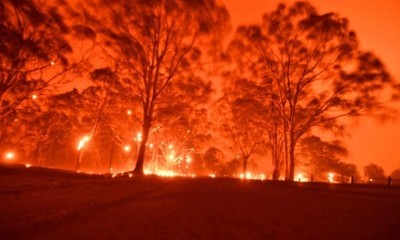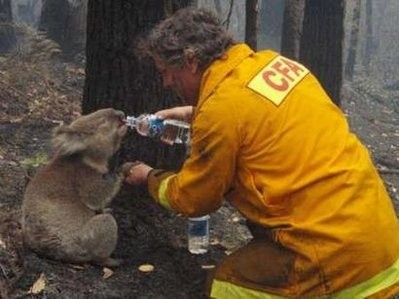From September through February, Australia battled the worst bushfires in its history. The root cause of the blaze was suspected spontaneous combustion caused by lightning. However high temperatures, drought and an abnormal climate transformed the small flare into a massive wildfire that rapidly spread across the southeastern part of the nation. According to the World Wide Fund, the Koala is now at risk of extinction as at least 1.2 billion wild animals were killed. The fire caused severe damage to the ecosystem and the nation is still reeling from its impact.
 |
| ▲ A serious bushfire broke out in Australia (Photo from Getty images) |
The Dankook Herald interviewed representatives at the Climate Research Division of the National Institute of Meteorological Sciences (NIMS). We learned that the main reason for the rapid spread of the fire was a lack of rain. According to the Australian Bureau of Meteorology, precipitation in New South Wales (NSW) from February 2017 to January 2020 was 916.7mm. This is the lowest recorded rainfall the country has seen in a century. The decrease in precipitation was more severe in winter. For the last three years, the average level of precipitation in NSW during the winter months was 150mm, which is deemed very low for this time of year. Furthermore, residents had to contend with a heatwave when it didn’t rain. 2019 recorded the hottest weather in observation history. This lack of precipitation coupled with the intense heatwaves perpetuated the fires. In addition, Eucalyptus trees contain a lot of oil and are hard to extinguish once set ablaze, causing the fires to continue to spread.
The persistent dry weather was attributed the Indian Ocean Dipole (IOD) otherwise known as the Indian Nino. This is when sea temperatures in the western Indian Ocean are warmer than the eastern parts. When the IOD is positive, an ascending air current is created, bringing high pressures and clear, dry weather to Indonesia and Australia. However, when the western side of the Indian ocean is relatively cool, a descending air current is created bringing with it low pressure systems and rain. Indonesia and Australia are currently experiencing a longer and more profound positive IOD due to climate change. Ascending air currents have caused droughts in Australia and instead brought heavy rains to East Africa, a region accustomed to drier weather.
The prolonged IOD meant the fires burnt for more than six months, causing a lot of destruction to the land. As the forests burned, concerns over desertification increased. 6.3 million hectares of forest were lost. New South Wales (NSW), saw the most damage with 5 million hectares of forests now covered in ash, while 1.1 million hectares were lost in Victoria. The bushfires also created a lot of dust, impacting air quality as far as Sydney and Canberra. In addition, an estimated 260 million tons of carbon dioxide (CO2) gas was emitted into the atmosphere. Meteorologists suggested that the increase in CO2 emissions from the Australia bushfires could further accelerate global warming.
The massive damage has had a significant impact on Australia's ecosystem. Ecologists at the University of Sydney estimate around 480 million creatures have been killed in the wildfires, including 8,000 koalas. Officials estimate that 30% of the Koala colony in NSW was destroyed as 10 million acres of land burnt. Also, 80% of wildlife habitat has been destroyed putting Koalas in danger of functional extinction. Currently, 113 species of animals are in need of emergency assistance.
The total amount of economic damage from the fires remains difficult to determine, as they continue to burn. However, consultants at SGS Economics & Planning estimate that the Sydney economy has suffered up to 50 million AUD in damages. Total property loss to date is more than 2,500 buildings including more than 1,300 houses and 33 people died, including 10 firefighters.
A lot of donations are being made to help Australia recover from the devastation. Multinational enterprise campaigns and other fundraising efforts are underway. To help wild animals, the Australian government has also announced an animal rescue plan with $50 million in wildlife emergency relief funds. An online Koala adoption system is underway to help injured Koalas recover. Rush, the cosmetic company will release 'all the wild things', a koala-shaped vegan soap, with all proceeds going to land restoration efforts and animal relief. Celebrity donations also continue to flow. Leonardo DiCaprio has donated $3 million to the Earth Alliance, while Chris Hemsworth donated $1 million. Hemsworth tweeted his pledge and asked his followers to join him in his efforts. The legendary heavy metal group Metallica pledged to donate $750,000 from their charitable foundation 'All Within My Hands'.
The need to restore the forests destroyed by these wildfires is clear. Without this habitat, indigenous species, known only to Australia, have nowhere to live and will not be able to recover. Although the disaster was caused by a strike of lightening, an abnormal climate fueled its extended progression and made it hard to extinguish. Climate change is real and nations and their citizens must do more to combat its progression and protect the environments we are living in.
 |
| ▲ Australian firefighters are feeding koalas rescued from wildfires (Photo by Pixicity) |
이지희, 박근후, 전소영 dankookherald@gmail.com

![[Campus Magnifier] Let's Surf the Library!](/news/photo/202404/12496_1765_4143.jpg) [Campus Magnifier] Let's Surf the Library!
[Campus Magnifier] Let's Surf the Library!
![[Campus Magnifier] Let's Surf the Library!](/news/thumbnail/202404/12496_1765_4143_v150.jpg)





